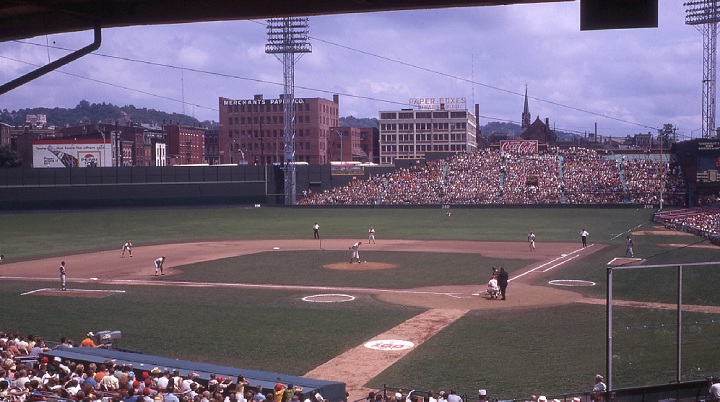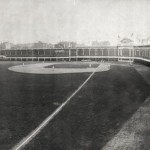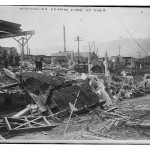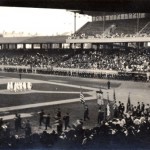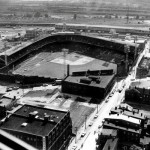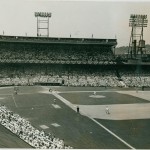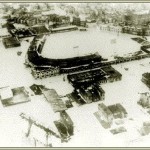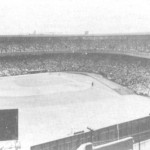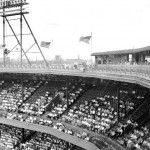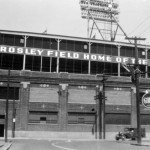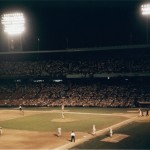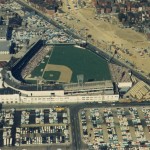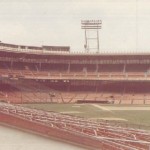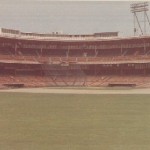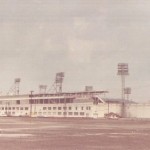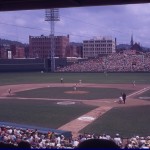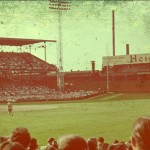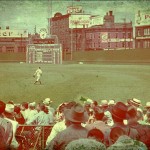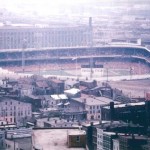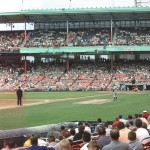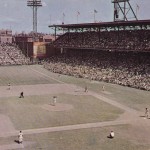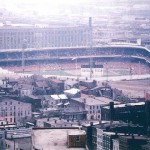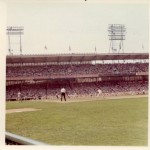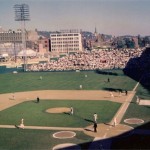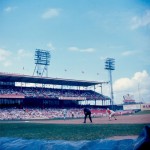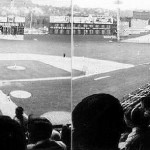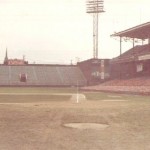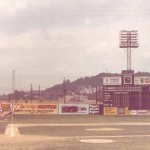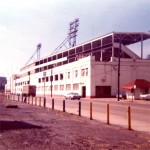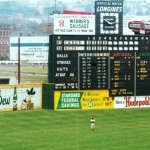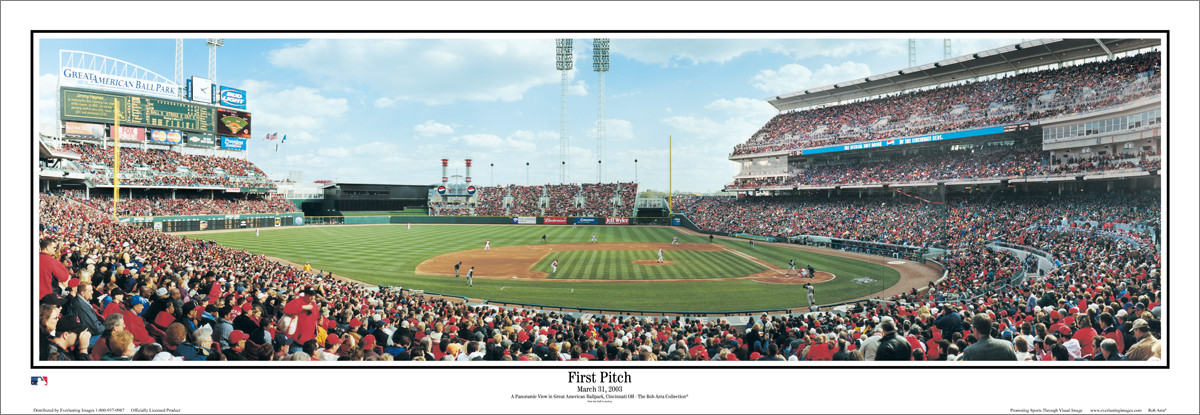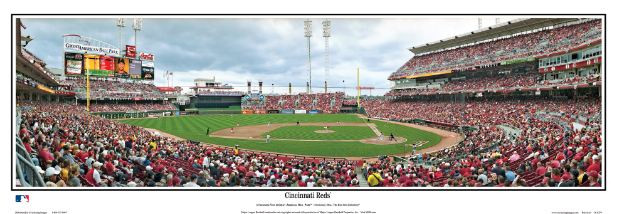America’s beloved pastime, baseball, traces its professional roots to the City of Cincinnati and the establishment of the Cincinnati Red Stockings in 1869. Although winning 130 straight games in 1869 and 1870, the Red Stockings dissolved after the 1870 season. A new Red Stockings team was found in 1876 as a member of the National League but were expelled from the league after the 1880 season. The franchise that became today’s Cincinnati Reds were found in 1881, began playing in the American Association in 1882 and in the first of seven ballparks the Red have called home, Bank Street Grounds. The ball club played two seasons here before moving a mile southeast where professional baseball would be played for 86 seasons.
Bound by Findlay Street, Western Avenue, York Street and McLean Avenue, a small grandstand, American Park, was constructed for the 1884 season. In 1890 the park was named League Park as the Reds moved to the National League. Four years later, the diamond was shifted to the southwest corner and a 6,500 seat grandstand was built. A fire burnt this grandstand on May 28, 1900 forcing the team to shift the diamond back to the southeast corner where the original American Park grandstand stood. Owner John Brush constructed a new ballpark, Palace of the Fans, for the Reds. Opening on April 17, 1902, the ballpark was unlike any other in baseball. Built of concrete, it featured a facade featuring ornament Corinthian columns and opera style private boxes. These private boxes, the first luxury suites in baseball, were at field level with the main grandstand at top. It had a seating capacity of 6,000 that included the grandstand from American Park (now in the outfield). It was home to the Reds for nine seasons before becoming to small, falling into disrepair and the structure caught fire after the 1911 season.
| MEMORABLE MOMENTS AT CROSLEY FIELD |
|
The ballpark some fans still remember today was built between the 1911 and 1912 seasons. The Palace of the Fans was demolished and replaced with a steel and concrete structure named Redland Field. On May 18, 1912 the Reds played their first game at Redland Field against the Chicago Cubs. Fans would arrive at the ballpark and met with a structure featuring a brick facade and seating for 22,000 inside. The lower deck grandstand stretched from the right field foul pole to homeplate and to the left field foul pole. An upper deck stretched from homeplate to past the first and third bases. Bleachers were located in right field and came to a point in right-center field becoming known as the sun deck. The most distinguishing feature of this ballpark was the terrace in front of the left field fence. It was an incline that started 20 feet from the left field wall and gradually increased until it reached the four feet grade at the wall. Original dimensions at Redland Field were 360 ft. (right and left) and 420 ft. (center).
When the Reds played in their first World Series in 1919, the street behind left field was blocked off and temporary stands were constructed. To further increase the seating capacity, portable seats were added in front of the lower deck. In 1926 these portable seats were replaced with permanent box seats. Homeplate was moved forward 20 feet creating new dimensions at Redland Field: 339′-L, 395′-C, 383′-R. In 1934 Redland Field received the name it is primarily known as, Crosley Field. Radio manufacturer, Powel Crosley Jr. purchased the Reds and named the ballpark after himself.
A revolutionary change in Major League Baseball occurred in 1935 at Crosley Field. Amidst the Great Depression of 1930s some teams struggled to attract fans to their ballparks. If fans were able to find a job during this time period it meant they would be unable to attend a game since all games were during the day. The solution: Installation of lights. Night baseball was not new as lights had been installed at Minor League ballparks beginning in 1930. Baseball granted the Reds permission to install lights, costing $50,000. On May 24, 1935 Crosley Field became the first professional baseball stadium with lights when President Franklin Roosevelt flipped the switch from Washington, DC. The Reds played eight home, night games against each National League team and saw their attendance increase by 100 percent.
A devastating flood hit Cincinnati in January 1937, flooding Crosley Field with 21 feet of water leading to a massive cleanup of the ballpark. The most extensive expansion project at Crosley Field was completed in 1938. A press box was built on the roof of the second deck and the second deck was extended to the left and right field foul poles. Other changes at Crosley Field throughout its history include the addition of an area of seating known as the “goatrun” in front of the right field fence in 1946. A 58 foot tall scoreboard with a Logins Clock on top replaced the original scoreboard in right center field in 1957. Crosley Field’s original brick facade was painted white in 1961.
Throughout the 1950s and 1960s population shifts led to many fans moving to the suburbs and an increase of fans wanting to drive to the ballpark. The area surrounding Crosley Field lacked sufficient parking and this coupled with an increase in crime and the neighborhood becoming blighted led to the demise of the ballpark. A professional football franchise, the Cincinnati Bengals, were established in 1966 and the City of Cincinnati decided to build a new multipurpose stadium for the Bengals and Reds along the Ohio River. The 1969 season was suppose to be the Reds final season at Crosley Field but construction delays led to the team playing part of the 1970 season at the ballpark. On June 24, 1970 the Reds played their last game at Crosley Field against the San Francisco Giants. Homeplate was moved to the Reds new home Riverfront Stadium in downtown Cincinnati.
Other events at Crosley Field included football, concerts and circuses. Broadcasters used a laundry center with advertisements on top of the roof to determine homerun distances until it was demolished in 1961 to make room for parking. Crosley Field stood for two more years after the Reds moved into Riverfront Stadium, serving as a auto impound lot until it was demolished in 1972. However, Crosley Field was brought back to life, once in Kentucky and now in Blue Ash, Ohio. The replicated Crosley Field at the Blue Ash Sports Complex features a playing field featuring the exact dimensions, 400 original seats and a replicated scoreboard from the final game.

